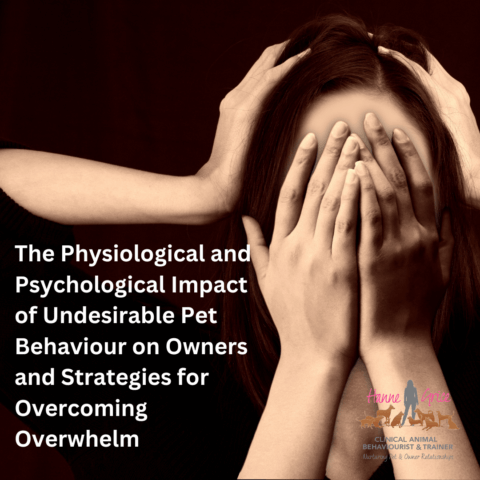
Pets bring joy, companionship, and love to our lives, but sometimes, they may also exhibit undesirable behaviour that can negatively impact their owners. Whether it’s excessive barking, lunging on the lead, or snapping, biting, destructive tendencies, dealing with problematic pet behaviour can lead to physiological and psychological challenges for their carers. This article explores how undesirable pet behaviour can affect owners, keepers and carers from both physiological and psychological perspectives and offers practical strategies to help overcome the overwhelm associated with these challenges.
Physiological impact of undesirable pet behaviour on owners
- Stress response: Constant exposure to a pet’s undesirable behaviour, such as incessant barking, lunging on lead, or snapping, can trigger a stress response in the owner. The body releases stress hormones like cortisol and adrenaline, leading to increased heart rate, blood pressure, and muscle tension. Prolonged stress can have detrimental effects on the immune system and overall health. Data also suggests a significant positive correlation between the cortisol levels of the owners and their dogs, indicating that when one in the owner-pet relationship is stressed, this influences the other’s cortisol levels (Graham et al., 2019). Similarly, research shows that when the owner’s heart rate increases, so does their dog’s; further supporting evidence that physiological states between owners and their pets are interlinked (Romero et al., 2013).
- Sleep disturbances: Pets with disruptive behaviour, especially nocturnal activities like excessive meowing or scratching, can disrupt their owner’s sleep patterns. Sleep deprivation can lead to reduced cognitive function, mood disturbances, and impaired overall well-being. Lowered tolerance levels from a lack of sleep can, understandably, lead to the increased likelihood of frustration, which may be directed towards the pet, impacting the pet-owner bond.
- Physical injuries: Aggressive or overly energetic pets may inadvertently cause physical injuries to their owners, such as cat or rabbit scratches, animal bites, or falls such as when a dog suddenly lunges out on their lead upon sight of a squirrel or another dog – taking their owner with them. These injuries can lead to pain, discomfort, and potential complications.
Psychological impact of undesirable pet behaviour on owners
- Anxiety and worry: Owners may become anxious and constantly worry about their pet’s behaviour and how it may impact their well-being or the safety of others. This can knock the owner’s confidence and trust in their pet. The persistent worry may lead to generalised anxiety and emotional distress. Hence, the emotional toll of dealing with problematic behaviours can be overwhelming, causing a perpetual state of anxiety and strain. For instance, a dog with severe separation related problems, may bark incessantly and destroy furniture when left alone, leading the owner to fear leaving the house and disrupting their daily routines. This constant worry can impede the owners from enjoying social activities, work, or even simple tasks like running errands. Buller at al. (2020) found owners who reported having problems with their pets had to dedicate extra time for management and training. They also had difficulty exercising their pet, and there were limitations on where they could go and who could visit their home, and the pet’s undesirable behaviour directly or indirectly affected household relationships and those with family and friends.
- Guilt and frustration: Owners may feel guilty or frustrated when they are unable to effectively address their pet’s behaviour issues. The guilt stems from the belief that they are somehow responsible for their pet’s behavioural issues, leading to self-doubt and a sense of failure. For instance, if a dog exhibits aggression (lunging, barking, growling) towards other dogs on walks, the owner may blame themselves for not properly socialising the dog during his or her early stages of development. This guilt can be exacerbated when the owner witnesses the negative impact their pet’s behaviour has on others, such as causing fear or harm to other animals or people. The frustration arises from the constant struggle to find effective solutions and techniques to manage the problematic behaviour. No matter how much effort the owner puts into training, behavioural modification, or seeking professional help, progress may be slow or limited, leaving the owner feeling helpless and overwhelmed. The combination of guilt and frustration can take a toll on the owner’s mental well-being, leading to heightened stress levels, feelings of inadequacy, and a diminished sense of enjoyment in the companionship of their pet. These negative emotions can strain the human-animal bond and cause feelings of helplessness.
- Social isolation: Owners with pets exhibiting undesirable behaviour may avoid social situations due to embarrassment or fear of their pet’s behaviour. For example, a dog that consistently displays aggressive behaviour towards guests may isolate the owner from inviting friends and family over, leading to feelings of loneliness and isolation. This isolation can lead exacerbate psychological distress, resulting in a reduced quality of life….
- Reduced quality of life: Living with constant stress and worry over pet behaviour can diminish the owner’s overall quality of life, as well as the pet’s. It may limit their social interactions, impede their ability to relax, and creates a sense of constant vigilance. The reduced quality of life stemming from living with the constant stress and worry over a pet’s behaviour is palpable, as it can rob animal carers of their peace of mind, it disrupts their daily routines, and creates a sense of constant apprehension and unease.
Strategies to overcome overwhelm

- Seek professional help: With the animal behaviour and training industry yet to be formally regulated by the government, it is critical owners and carers enlist the services of a certified animal behaviourist who can assess your pet’s behaviour and create a tailored behaviour modification plan, in conjunction with your veterinary surgeon. The internet and social media is awash with out-dated advice and inappropriate handling methods which can make finding the appropiate support, challenging. Furthermore, anyone can call themselves a ‘behaviourist’. This presents challenges to pet carers when seeking the right advice and support. To find a certified professional who has been assessed in their knowledge, understanding and practical skills to the Standard at which they are practicing, and can support you throughout the process, check out the Animal Behaviour and Training Council’s Practitioner Directory. This directory lists rigorously assessed Clinical Animal Behaviourists (CABs), Veterinary Behaviourists (VBs – vets who are also CABs), and Animal Behaviour Technicians (ATBs) who are registered with the ABTC and near you. Note: only CABs and VBs should be working with aggression cases, however trainers can work in conjunction with a CAB/VB to support their clients. All practitioners should work to their level of competency; referring on when needed.
- Positive Reinforcement Training: Utilise positive reinforcement techniques to reward desired behaviours in your pet. By offering treats, praise, playtime, sniffing opportunities, and touch (if your pet enjoys tactile interactions) for great behaviour, you can motivate your pet to repeat those actions. Avoid shouting, hitting, spraying or using other forms of punishment as this can lead to greater pet stress and anxiety and can risk escalations such as a bite (Ziv et al., 2017). Click this link to see the list of Aversive tools/equipment and punishment-based handling methods you want to avoid via the ABTC.
- Consistency and patience: Behaviour change takes time, and it is not a linear process. So be patient with your pet and yourself. Consistent reinforcement and clear boundaries are essential for helping your pet understand the desired behaviours.
- Create a safe environment: Make adjustments to your pet’s environment to reduce triggers for undesirable behaviour. For example, if your dog frequently barks at passers-by an external-facing window, you could place opaque film onto the window which allows for natural light to filter through but stops visual access to such triggers; this can immediately reduce the practice of barking at the window. It is also important to review and provide ample mental and physical stimulation, such as through interactive toys, allowing for sniffing on walks and around the garden with hidden food rewards and toys, plus regular daily exercise appropiate to your pet’s species, breed, age, state of health, and weather conditions etc.
- Practice self-care: It is important for owners that live with problematic pet behaviours to engage in stress-reducing activities, such as mindfulness exercises, deep-breathing techniques, regular physical activity, spending time with supportive friends and family, and joining community hubs such as online forums or groups where other owners may be experiencing similar problems – this enables you to talk through shared experiences. Taking care of your well-being can better equip you to handle the challenges of undesirable pet behaviour.
Key take-aways for owners
Undesirable pet behaviour can have significant physiological and psychological impacts on owners. The stress, anxiety, and frustration associated with such behaviour can take a toll on an individual’s overall well-being. However, by seeking appropiate professional help from assessed and certified animal practitioners and your vet, employing positive reinforcement training methods, and practicing self-care, owners can overcome the overwhelm, and work towards fostering a more harmonious relationship with their pet.
Remember, addressing undesirable pet behaviour is a gradual process, and with patience and persistence, positive changes are achievable.
References:
- Overall, K. L. (2013). Manual of Clinical Behavioral Medicine for Dogs and Cats. Elsevier Health Sciences.
- Beaver, B. V. (2009). Canine Behavior: Insights and Answers. Saunders.
- Buller, K. and Ballantyne, C. (2020). Living with and loving a pet with behavioral problems: Pet owners’ experiences, Journal of Veterinary Behavior, 37, 41-47. https://doi.org/10.1016/j.jveb.2020.04.003.
- Graham, L., Wells, D. L., & Hepper, P. G. (2019). The influence of human–animal interaction on cortisol levels and sleep in veterinary students. International Journal of Environmental Research and Public Health, 16(6), 978.
- Lundberg, U., & Frankenhaeuser, M. (1980). Pituitary-adrenal and sympathetic-adrenal correlates of distress and effort. Journal of Psychosomatic Research, 24(3-4), 125-130.
- Horwitz, D. F., & Mills, D. S. (2009). BSAVA Manual of Canine and Feline Behavioural Medicine. BSAVA.
- Oliva, J. L., & Johnston, K. L. (2013). Animal-assisted therapy for military veterans: A systematic review. Journal of Rehabilitation Research and Development, 50(6), 871-884.
- Romero, T., Nagasawa, M., Mogi, K., Hasegawa, T., & Kikusui, T. (2013). Heart rate variability of dogs in response to their owners’ faces. Journal of Veterinary Behavior, 8(3), 213-218.
Learn more about our classes

Get Hanne's book, clothing and more
Hanne has a number of publications including her book Playing With Your Dog to help owners work out the games that are best suited for their pet to play throughout his life, from puppyhood to old age, available from Amazon. Check out Hanne's range of contemporary casuals The Collection – for pet lovers made from recyclable, organic materials that are sustainably sourced.

